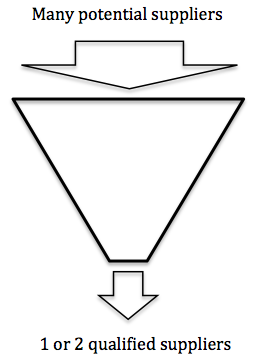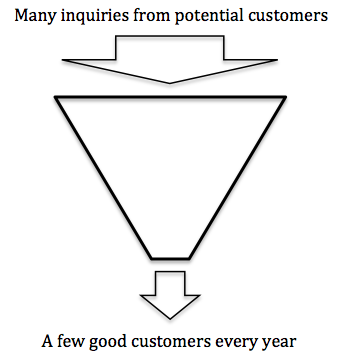 Sourcing a good supplier that offers a competitive price is hard. There is a lot of “noise” to filter out in that search process.
Sourcing a good supplier that offers a competitive price is hard. There is a lot of “noise” to filter out in that search process.
But did you wonder what that process looks like on the supplier’s side? Maybe it would help you improve the effectiveness and the speed of your sourcing process.
The sourcing process, on the buyer’s side

There are usually three phases:
- Identification of lots of potential suppliers
- Screening (RFQ – sampling)
- Verification
At the end, with a bit of luck, the buyer has approved a couple of suppliers that have a suitable profile (in that article I suggested 6 criteria to look out for). One supplier may be kept as backup.
Tips for purchasers
Do you want to receive less email? contact less suppliers at the beginning.
How to contact less suppliers, while casting a wide net? Spend more time upfront on the B2B directories, use their advanced search features, and bundle the identification and screening phases as much as possible.
The selling process, on the supplier’s side

Not surprisingly, the selling process is a mirror image of the sourcing process:
- Reception of raw inquiries
- Being screened
- Being verified
Chinese suppliers also have an ideal customer profile in mind. I guess it often looks like this:
- Is not a beginner (no need to explain the basics to him, and low chance of dropping the order).
- Can buy above the minimum order quantity.
- Is willing to pay a decent price, with reasonable payment terms.
- Already knows precisely what he wants (product and quantity).
- Will buy large volumes and will place repeat orders.
- Does not require long and complex development before production can start.
- Buys direct from an oversea country. No local agent to bother us or to get kickbacks.
Tips for purchasers
The first message should be short, less than 8 lines if possible (including the product description), and with a clear call to action (“get back to me if you want more information about our needs”) in bold.
If possible, contact them through a B2B directory they pay for (they will tend to place more value on your inquiry). The messaging process will push you to make your inquiry easier to understand .
The most important is to MOTIVATE the suppliers you contact. Good suppliers don’t have time to respond to all inquiries. How to motivate them? If you share some characteristics with their ideal customer profile, make sure it is clear in your first emails.
If you have a product specification sheet (or, even better, an inspection checklist), share it with them and get their feedback. You will see if they ask questions, if they say “it’s all OK” (not a good sign), if they don’t accept your tolerances, and so on.
And then… Follow up FAST in responding to their questions, and finalize your screening process within 8 days. After that, your business opportunity will have gotten cold in their eyes.
If possible, call them (most of them have a Skype account).
Do you have any other tip?
—
PS: if you liked this article, you can subscribe so that you receive future articles by email. Just click here. Thanks!
